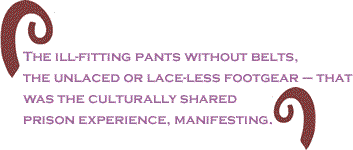
|
|||||||||||||||||||||
 |
Mass incarceration is by far the greatest crisis facing Black America, ultimately eclipsing all others. It is an overarching reality that colors and distorts every aspect of African American political, economic and cultural life, smothering the human – and humane – aspirations of the community. Even the boundless creativity of youth cannot escape the chains that stretch from the Gulag into virtually every Black social space. We hear prison, talk prison, wear prison and – to a horrific degree – have become inured to the all-enveloping presence of prison in virtually every Black neighborhood and extended family. After more than three decades of mass Black incarceration as national policy, Black America teeters at the edge of an abyss, unable to muster more than a small fraction of its collective energies to advance its agenda in housing, employment and education. The community has been poisoned by massive, ever increasing infusions of the prison experience – a debasement that now permeates much of the fabric of Black life. Yet mass Black incarceration is not a political priority for much
of what passes for Black leadership. A deep and historical current
in Black America feels far more shame than anger at the ever lengthening
line of march through the prison gates. For others, the incremental
blending of community and prison through the constant human traffic
between the two, seems like a natural state of affairs.
When Black anger does erupt, it is too often
directed only at those who are already paying for having been
caught up in the
induction mechanisms of the Prison Nation. Although it is true
that few inmates are “political prisoners” in the narrow sense
of the term, America’s rise as the world’s prison superpower
was certainly the result of calculated political decision-making. “Mass
incarceration was the national response to the Civil Rights and
Black Power Movements, a white societal reaction to Black intrusions
onto white ‘space,’” wrote
Since 1971, U.S. prisons and jails have grown
ten-fold – from
less then 200,000 inmates to 2.1 million – while whites have
The U.S. broke with historical patterns of incarceration – a little over 100 prisoners per 100,000 population – in the mid-Seventies. Then, with roughly equal fervor, Presidents Reagan, Bush, Sr. and Clinton and each of the states methodically assembled the world’s largest Gulag. As the Justice Policy Institute reported in 2001, the Black prison population exploded.
The Institute notes that, “In 1986 and 1988, two federal sentencing laws were enacted that made the punishment for distributing crack cocaine 100 times greater than the punishment for powder cocaine.” No, Black crack dealers and users are not “political prisoners” – but they are imprisoned for long stretches and in huge numbers for what are clearly political reasons.
Unless there exists a Black “prison gene,” politics is the reason that 12 percent of African-American men ages 20 to 34 are in jail or prison. The evidence is irrefutable: mass incarceration of African Americans is national policy. Last month the U.S. Justice Department announced that the U.S. incarceration rate had risen to 715 per 100,000 – up from 703 the previous year, and seven-times the levels that existed before mass incarceration of Blacks became national policy. Crime rates remain historically low – a disconnect that Attorney General John Ashcroft rationalized, this way: "It is no accident that violent crime is at a 30-year low while prison population is up. Violent and recidivist criminals are getting tough sentences while law-abiding Americans are enjoying unprecedented safety." Thus, the engines of mass Black incarceration keep turning, faster and faster every year, whether crime is up or down. The only constant: more Blacks in prison. Misplaced rage National policies are far more powerful than conspiracies, which tend to die with the men who hatch them. The U.S. policy to imprison ever higher proportions of the Black population, is open-ended – there appears to be no limit. Yet, as the incarceration machinery grinds away at Black society, internal voices full of hatred for other Black people join the racists in turning reality on its head, blaming African American “culture” for the relentless warehousing of Black men, women and juveniles. Clearly, the reverse is true: prison has worked its corrosive effects on Black culture.
African American culture has been profoundly victimized by three decades of mass incarceration. This is largely the fault of those Blacks who failed (or refused) for all these years to mount sufficient political resistance to the prison body-snatchers. It is both cruel and redundant to heap more scorn on people who are, quite literally, besieged by a hostile state. By the mid-Eighties, only a (culturally) blind person could have failed to see that the prison experience had reached critical mass among Black youth in America’s big cities. The ill-fitting pants without belts, the unlaced or lace-less footgear – that was the culturally shared prison experience, manifesting. The hip hop “sensibility” cannot be separated from the pervasiveness of prison – its presence in ghetto life. It is the now-inescapable influence – the logical cultural product of objective facts.
There is much more horror in the prison pipeline, which empties directly into the reservoir of Black life. Self-righteous howls of indignation at the warping of Black culture are irrelevant to the millions of African Americans who have been made witness, victim or perpetrator of rape – a near-universal experience in the Black American Gulag. In such a world, everything and everyone is a “bitch.” Prison rape pervasive
At least 90% of assaults are not even reported to staff. The units with the younger offenders seem to carry by far the higher rates of sexual assaults. – Texas inmate R.B. to Human Rights Watch I have seen or heard of rapes on a weekly basis at the least. Mostly it is a daily occurrence. Rapes are a very common occurrence due to the fact of coercion being "played" on ignorant first timers. Once someone is violated sexually and there is no consequences on the perpetrators, that person who was violated then becomes a mark or marked. That means he's fair game. – Indiana inmate M.B. Each year, hundreds of thousands of young Black men and boys (and record numbers of women and girls) are immersed in the most intensely coercive environment imaginable. Older inmates and ex-prisoners uniformly report that prison rape has become exponentially more prevalent, with gangs dominating the closed world behind the bars. Human Rights Watch activist and lawyer Joanne Mariner, writing in FindLaw, reported extraordinary levels of sexual assault.
Mariner spent three years soliciting over a thousand letters about rape from prison inmates, which she compiled in a book, No Escape: Male Rape in U.S. Prisons. Human Rights Watch and Stop Prison Rape found allies in strange places – among white Southern Baptists, born again Watergate convict Charles Colson, and the rightwing Hudson Institute. In the end, a coalition of 32 groups, ranging from the NAACP to the National Council of La Raza and the National Association of Evangelicals, won congressional passage of the Prison Rape Elimination Act, signed into law by President Bush last September. Pat Nolan, Vice President of former Nixon aide Charles Colson’s Prison Fellowship, wrote:
The legislation provides $40 million in grants for rape prevention – the bulk of which are likely to be awarded to religious groups associated with the bill’s conservative supporters – authorizes a Department of Justice panel to subpoena officials at prisons with high sexual assault rates, and creates an independent, nine-person commission on prison rape. The Department of Justice in March released a report on its preliminary discussions for implementing the legislation.
For all its good intentions, however, the bill is ill-equipped to deal with the prison rape horror. The same congressional conservatives who embraced the Prison Rape Elimination Act in 2003, were also responsible for passage in the Nineties of legislation that effectively denied prison inmates access to the federal courts. “They can be abused, tortured, raped without effective recourse to law,” said Anthony Lewis, in an April, 2001 column:
Without basic constitutional rights, inmates remain at the mercy of the prison bureaucracy – the very men who oversee and orchestrate the barbarity. Lords of discipline They wanted to humiliate us. It was disgusting. They covered our heads with plastic bags and hit our backs with sharp objects, which added to our wounds. They then took off all our clothes, made us stand next to the wall and carried out immoral acts that I cannot even talk about. Women soldiers took pictures of naked men and did not care.” – Iraqi former prisoner Hashim Muhsin, speaking to Al Jazeera Charles was just filled with the glee of opportunity to go over there, because he said as we're walking down the corridor, "I can't wait to go kill some sand niggers." That smile he showed, he showed best when he was getting some prisoner to lose it, to snap, to lose his mind and scream at Charles. He loved it. – Former death row inmate Nicholas Yarris, recalling to CNN his memories of prison guard Charles Graner, later charged with abusing prisoners at Abu Ghraib. Texas prison inmates continue to live in fear. More vulnerable inmates are raped, beaten, owned, and sold by more powerful ones. Despite their pleas to prison officials, they are often refused protection. Instead, they pay for protection, in money, services, or sex. – Texas Judge William Wayne Justice, after hearing lengthy expert and inmate testimony on prison conditions.
The Black clergy did not take the lead in championing the Prison Rape Elimination Act. And it was factors wholly external to the African American community – the Iraqi prisoner abuse scandal – that indirectly brought media attention to the savagery of U.S. prisons, where the Iraq malefactors learned their psycho-sexual torture skills. In a May 8 New York Times article, Fox Butterfield drew a direct line between Abu Ghraib and the American Gulag.
Fellow Timesman Bob Herbert, in a May 31 column, described a 1996 Georgia Department of Corrections raid on inmates' living quarters at Dooly State Prison:
Scenes of Iraqi torture miraculously gave media credibility to long-ignored pleas for justice in the U.S. prison system. The Newark Star Ledger gave space to a letter from Bonnie Kerness, of the Quakers’ Prison Watch Project:
The plight of Iraqis, who will one day soon be rid of their racist, exually twisted American guards, inadvertently invigorated discussion of American prison practices. It took an international spotlight on Iraq to shed temporary light on an American story that is older than the nation, itself – as old as slavery. Prison teaches “assertiveness” As Philip Weiss wrote in the June 17 issue of the New York Observer, prison rape is “deeply ingrained in the culture, and we’re all inured to it. There’s contempt for prisoners, and it’s also a hugely uncomfortable topic for men to think about." More accurately, white society considers Black prisoners to be animals beyond the reach of civilization. In the popular imagination, prison rape is what happens to white boys unfortunate enough to wind up behind bars despite the odds. In reality, since rape is a tool of coercion, every prisoner is vulnerable – and every inmate is deeply harmed by his/her experience in such an environment. The American prison system is a vast enterprise in social engineering – it turns out damaged people. Arizona prison warden Bill Gaspar is truly a mad social scientist. The threat of rape has a salutary effect, in his mind:
The warden thinks prison teaches inmates to “assert themselves.”
Some liberal politicians share the same worldview as the troglodytes, regarding prison rape. California Attorney General Bill Lockyer wants to punish Enron’s Ken Lay for bilking the state of billions in electricity overcharges. "I would love to personally escort Lay to an 8-by-10 cell that he could share with a tattooed dude who says, 'Hi, my name is Spike, honey.'" The state’s top law enforcement officer approves of nonjudicial punishment by rape. The words “cruel and unusual” do not exist for Supreme Court Justice Clarence Thomas. Human Rights Watch prisons activist Joanne Mariner writes:
Consumed by prison Youth are not at fault for the social disarray in Black America. Young people in all cultures cope with society as it is presented to them. Black youth – male and female – face a state that is eager to consume them in its criminalizing, mass Black incarceration machinery. The only meaningful choice available is to organize as never before to dismantle the savage machine, so that another generation will not be irrevocably damaged. Young people by the millions would join in such a mobilization – to save themselves. It has been projected that, by 2010, the number of Americans with experience in prison will rise to 7.7 million, up from 5.6 million in 2003. About 4 million of them will be African American – unless we stop the clock through concerted political action. |
June
17 2004 |
|||||||||
|
|||||||||
|
|
|||||||||
| Printer Friendly Version | |||||||||
 |
|||||||||
| |
|||||||||
| |
|||||||||

































